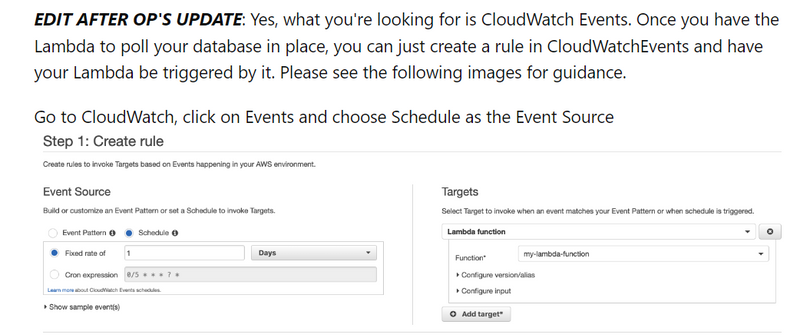S3 Image Processing (using Pillow):
from PIL import Image
import boto3
import os
def lambda_handler(event, context):
s3 = boto3.client('s3')
bucket_name = event['bucket_name']
file_key = event['file_key']
# Download image from S3
local_path = '/tmp/' + file_key
s3.download_file(bucket_name, file_key, local_path)
# Process image (resize)
image = Image.open(local_path)
resized_image = image.resize((100, 100))
# Save processed image back to S3
processed_key = 'processed/' + file_key
local_path_processed = '/tmp/' + processed_key
resized_image.save(local_path_processed)
s3.upload_file(local_path_processed, bucket_name, processed_key)
return f"Image {file_key} processed and saved as {processed_key}."
Input:
{
"bucket_name": "your-s3-bucket",
"file_key": "example.jpg"
}
Output:
save this file as resize_file.py
If you've deployed the Lambda function with the AWS CLI, you can find the function name or ARN in the AWS Lambda Console or by using the AWS CLI:
aws lambda list-functions
"Image example.jpg processed and saved as processed/example.jpg."
6-10: DynamoDB Operations
To integrate the provided AWS Lambda function for image processing (resizing) with a Django project, you can create a Django view that triggers the Lambda function. The Django view can receive the S3 object-related information (bucket name and file key) from a client and invoke the Lambda function using the Boto3 library. Below are the steps and an example implementation:
Configure Boto3 in Your Django Project:
Install the boto3 library if you haven't already:
pip install boto3
Configure AWS credentials in your Django project (either through environment variables, AWS CLI, or IAM roles). Ensure that the IAM role associated with your Lambda function has the necessary permissions to read from and write to S3.
Create a Django Template (image_process_form.html):
<!-- templates/image_process_form.html -->
<!DOCTYPE html>
<html>
<head>
<title>Resize and Download Image with Lambda</title>
</head>
<body>
<h2>Resize and Download Image with Lambda</h2>
<form method="post" action="{% url 'resize-and-download-image' %}">
{% csrf_token %}
<label for="bucket_name">Bucket Name:</label>
<input type="text" name="bucket_name" required><br>
<label for="file_key">File Key:</label>
<input type="text" name="file_key" required><br>
<button type="submit">Resize and Download Image</button>
</form>
</body>
</html>
Create a Django View (views.py):
# views.py
from django.http import JsonResponse
from django.shortcuts import render
import boto3
import json
def resize_and_download_image(request):
if request.method == 'POST':
try:
# Extract S3 object-related information from the form data
bucket_name = request.POST.get('bucket_name')
file_key = request.POST.get('file_key')
# Create a Boto3 Lambda client
lambda_client = boto3.client('lambda', region_name='your-aws-region')
# Invoke the Lambda function to resize and download the image
lambda_client.invoke(
FunctionName='resize_file',
InvocationType='Event', # Asynchronous invocation
Payload=json.dumps({
'bucket_name': bucket_name,
'file_key': file_key
})
)
# Return a JsonResponse indicating the successful initiation of the image resizing and download
return JsonResponse({'message': f"Image {file_key} resizing and download request sent to Lambda."}, status=200)
except Exception as e:
# Return a JsonResponse indicating an error if any occurs
return JsonResponse({'error': str(e)}, status=500)
else:
# Render the form for GET requests
return render(request, 'image_process_form.html')
Define URLs in Django (urls.py):
# urls.py
from django.urls import path
from .views import resize_and_download_image
urlpatterns = [
path('resize-and-download/', resize_and_download_image, name='resize-and-download-image'),
# Add other URL patterns as needed
]
Run Django Development Server:
Start your Django project's development server.
python manage.py runserver
Now, if you navigate to http://localhost:8000/resize-and-download/ in your browser, you should see the form for resizing and downloading an image with Lambda. Users can fill in the bucket name and file key, and when they submit the form, the image resizing and download request will be sent to the Lambda function.
Remember to replace 'your-aws-region' and 'your-lambda-function-name' with your actual AWS region and Lambda function name. Adjust the code based on your specific needs and requirements.



Top comments (0)